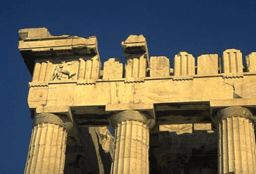Outline
Architecture: from Karnak to Florence
Around the year 1000 florishing abbeys and pilgrim routes to Rome and Compostella gave western building activities a strong boost. The history of medieval architecture can be read as one long search for an answer to the question 'how to build nice and large churches?' Local teams of stone workers and wood carvers haven't got a theoretical knowledge of the basic principles of stability. A church that falls down is built again in another way. A solution that's not nice isn't repeated. Arised by experiece regional schools devellop their own forms and technical solutions.
Starting with examples from Classical Antiquity we will illustrate the basic principles of stability and spanning in this GeoGebrabook. Then we will follow the medieval story from the earlier romanesque experiments to the spactacular gotic cathedrals.
400 year later Filippo Brunelleschi is a new game changer. In the dome of the Florence cathedral he still uses the pescribed gotic forms. But the common knowledge of a group of craftsmen is no longer the dominating factor in the building proces. This common knowledge is replaced by the geniality of the artist. So Brunelleschi marks as well the end of the gotic area as the beginning of renaissance.
Follow the story of bending joists, circular and pointed arcs in an architectural journey through time.

Table of Contents
Classical Antiquity
- Greek architraves
- Karnak: a forest of colums
- Roman circular arcs
- horizontal forces
- from a circular arc to a barrel vault
- from a barrel vault to a groined vault
- from a circular arc to a dome
- domes and half domes in the Aya Sofia
- how to support a spherical dome?
- dome with cantilever construction
- dome with pendentives
romanesque architecture
alternative solutions
gotic architecture
the dome of Brunelleschi